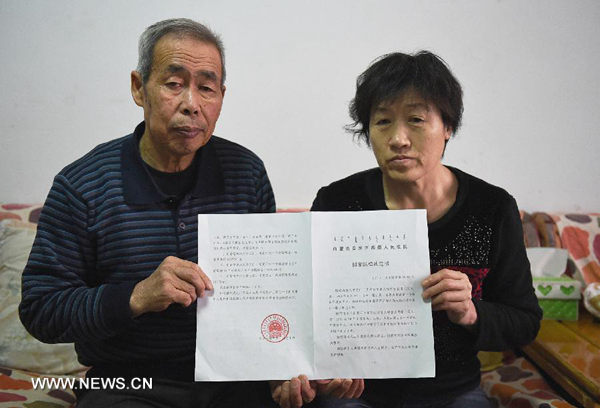Editor's note: Since the 18th CPC National Congress in late 2012, a number of key judicial reforms have been carried out.
As China enhances the rule of law in all respects, new progress has been made in the field of justice. The reform of the judiciary has gone to the next level, with improvements in the allocation of judicial powers and responsibilities, judicial accountability and opening-up, and protection of lawyers' right to practice.
Let's take a look at some of the key changes made in Chinese judicial reforms in the past five years.
|
Li Sanren (L) and Shang Aiyun, parents of Huugjilt, who was wrongly executed for rape and murder at age 18, show the verdict of state compensation totaling more than 2 million yuan (about $322,000) in Hohhot, capital of North China's Inner Mongolia autonomous region, on Dec 31, 2014. On Dec 15, 2014, the Inner Mongolia Autonomous Regional Higher People's Court overturned Huugjilt's previous conviction and ruled he was not guilty of rape and murder, saying that the facts of his case were unclear and evidence was inadequate. [Photo/Xinhua]
|
1. Preventing miscarriages of justice
In 2013, the Ministry of Public Security issued a circular on improving law enforcement to help prevent miscarriages of justice, along with other documents designed to stop improper verdicts and improve real-time scrutiny of law enforcement.
The Ministry of Justice strengthened forensic assessment management and further regulated such activities. The Supreme People's Procuratorate released a circular on preventing and correcting miscarriages of justice by improving procuratorial functions. The Supreme People's Court stipulated that defendants should be acquitted if evidence is insufficient.
From 2012 to 2017, a number of wrongful convictions were overturned in accordance with the law.
2. Improving the judicial accountability system
In September 2015, the Supreme People's Court promulgated certain opinions on improving the judicial accountability system in the people's courts to guide the pilot courts during the reform process.
Since the national conference on reform of the judicial system held in July 2016, changes to the judicial accountability system have been implemented nationwide. They include judge quotas and are centered on the operating mechanism of adjudicative power and the accountability system for judges and collegiate panels handling cases.
The Supreme People's Court has promulgated relevant regulations expressly providing that a judge shall be responsible for his or her performance of duties and the quality of cases handled. A judge shall be held liable for illegal adjudication if he or she intentionally violates the laws in adjudication or commits any gross negligence resulting in any wrong judgment and causing any serious consequences.
3. Circuit courts established across the country
In 2015, the Supreme People's Court set up its first and second circuit courts in Shenzhen and Shenyang for major cross-regional administrative, civil and commercial cases. That year, the circuit courts handled 1,774 cases and concluded 1,653 of them, concluding all cases within the time limit.
The year before, people's courts and people's procuratorates transcending administrative boundaries were established in Beijing and Shanghai to handle major cross-regional criminal, civil and administrative cases.
This was to address certain parties' concerns over the jurisdiction of their cases, and to promote the unified and correct application of laws.
4. Case-filing register system comes into operation
On May 1, 2015, a case-filing register system began operating. People's courts should accept and register all cases of litigation, handle all those that meet the conditions of admissibility and prosecution, ensure that all cases are entered and properly handled, and that litigious rights are exercised without obstruction.
From May to December 2015, 9.94 million first trial cases were registered at courts across the country, a year-on-year increase of 29.54 percent. The on-the-spot case registration accounted for 95 percent of all cases, among which civil cases increased 26.45 percent, administrative cases 66.51 percent and criminal cases 58.66 percent.
Difficulties in filing administrative lawsuits concerning housing demolition, land acquisition, and government information disclosure were significantly eased.
5 .Protecting lawyers' right to practice
China has made or revised laws and regulations to ensure lawyers' have the right to practice. In 2015, regulations were issued to clarify various measures to protect lawyers' right to practice, including the rights to know, to meet their clients and read case files.
In 2016, the General Office of the CPC Central Committee and the General Office of the State Council issued opinions on advancing reform in the lawyer system, aiming to safeguard lawyers' litigation rights, improving the mechanism for governments to purchase legal services and improving social security policies for lawyers.
By March 2017, all 31 provincial-level lawyer associations had established lawyers' rights protection centers. In April, a circular was jointly issued by the Supreme People's Court, Supreme People's Procuratorate, Ministry of Public Security, Ministry of State Security and Ministry of Justice to further clarify different departments' duties in safeguarding lawyers' right to practice.
6. Advancing criminal procedure reform
In October 2016, China issued guidelines on criminal procedure reform and the role of court trials in a bid to reduce wrongful convictions.
The guidelines issued by the supreme court and supreme procuratorate, along with the ministries of public security, state security and justice, seek to improve criminal procedure by enhancing the court's role in fact finding, identifying evidence, protecting rights and impartial judgment.
The 21-clause document stresses the presumption of innocence, identifies several major problems in the current litigation system, puts forward a package of changes to the rules of evidence and investigation, and sets out the court's key role as protecting the rights of all interested parties.
7. Public interest litigation allowed
In June, China's top legislature passed amendments to the civil and administrative procedure laws to allow prosecutors to institute public interest litigation.
Prosecutors are allowed to file civil lawsuits against any act that compromises public rights and interests related to protection of environment and resources, as well as food and drug safety, according to the amendment to the Civil Procedure Law.
Before amending the laws, the Supreme People's Procuratorate began a two-year pilot program in July 2015, allowing prosecutors in 13 provincial divisions to institute public interest litigation in administrative and civil cases. By the end of May 2017, procuratorates had handled 7,886 public interest lawsuits and filed 934 cases in the pilot reform.
8. Exclusion of unlawful evidence
In June, the Supreme People's Court, the Supreme People's Procuratorate, the Ministry of Public Security, the Ministry of State Security and the Ministry of Justice jointly released a regulation on the exclusion of illegally obtained evidence in criminal cases.
According to the regulation, confessions, witness testimony and depositions of victims obtained by force will no longer be accepted as evidence.
Defenders of criminal suspects are allowed to ask that illegal evidence be ruled out during investigations.








